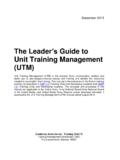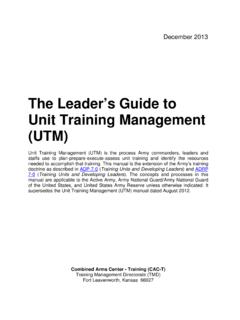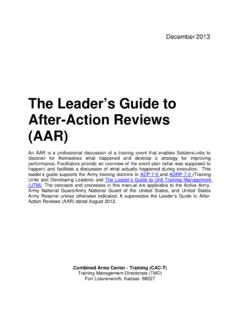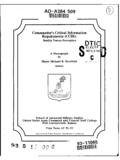Transcription of Executing Knowledge Management in Support of …
1 Executing Knowledge Management in Support of Mission Command for Leaders Army Operational Knowledge Management Proponent 1 April 2014. 1. KMOs ensure that the Commander .. as the leader and central figure in mission command .. has the right Knowledge from the various processes, from the right systems, at the right time, to make the right decision.. MG Thomas James, Jr. Director, Mission Command Center of Excellence Fort Leavenworth, 2014. 2. Forward This handbook provides Army leaders a better understanding of Knowledge Management , and what they can do to better manage the Knowledge processes in their units.
2 This handbook briefly addresses the roles and functions of leaders managing Knowledge Management Sections. The Army relies on Knowledge Management to assist the Commander and staff in developing more effective Mission Command processes. Knowledge Management is a key enabler in the Mission Command decision-making process. This handbook has been developed using lessons learned from soldiers in the field. Input was provided by Knowledge Management soldiers serving in units in the Trained/Ready and Available/Deployed phases of ARFORGEN, and the Combat Training Centers (CTCs).
3 Some key lessons learned include .. Leadership must actively participate and Support the Knowledge Management program; gaining that leadership involvement must be one of the organizations first objectives. Knowledge Management must be initiated during the plan/prepare phase of operations (Reset phase of ARFORGEN); the program is unlikely to succeed if the unit waits until execution. Knowledge Management is an iterative process; a series of small changes will build into the larger changes desired, with less turmoil. Knowledge Management is a people-centric process; the technical systems enable the Knowledge Management process, but cannot be the focus of it.
4 Andrew M. Mortensen LTC, AR. Chief, AOKM Proponent 3. 4. Purpose of This Handbook The purpose of this handbook is to help Army leaders establish and manage Knowledge Management in their organization. This handbook provides one approach to managing a Knowledge Management program. The tasks in this handbook are designed not as a systematic method of implementing Knowledge Management but as a means to generate thoughts and ideas on how Knowledge leaders can manage organizational Knowledge Management programs. This handbook is intended as a companion manual to Executing Knowledge Management in Support of Mission Command, Establishing a Knowledge Management Program (The KMO Handbook), and Executing Knowledge Management in Support of Mission Command, Knowledge Management Representatives (The KMR Handbook).
5 These handbooks presume a new division Knowledge Management Officer (KMO) who has read, and is implementing the concepts in those handbooks. As a result, this handbook is also based a division staff scenario, though the concepts in this handbook can be adapted to any organizational level. This handbook incorporates lessons learned from a variety of organizations which have established a successful KM program, but is not formal Army doctrine. Before you begin using this handbook, read and understand FM , Knowledge Management Operations (July 2012).
6 It will provide the background necessary to understanding this handbook. 5. Knowledge Management adds understanding and precision to mass and firepower.. BG Charles A. Flynn Acting CG, U. S. Army Combined Arms Center Fort Leavenworth, 2011. 6. Why Knowledge Management ? The concept of collecting, analyzing, and distributing Knowledge is not new to the U. S. Army. From the inception of the Continental Army in 1775, General George Washington developed organizations and processes designed to collect and disseminate information about British and American forces.
7 Which means, the basic concepts of Knowledge Management are not new to the American Army; what is new is how we think of about the Management of that Knowledge . Knowledge Management (KM) can be thought of as many things, and in the academic world there are hundreds of perspectives, theories, and definitions of KM. There are so many different perspectives of what would seem to be a simple subject that it can be difficult to grasp;. especially when those academics are applied to a military context. The Army, however, has an advantage over the academic world in that we have doctrine.
8 Which provides common definitions, terms, and techniques. Though KM doctrine is still emerging, it has developed enough that KM doctrinal concepts and techniques, are being employed across the Army with important results. In order for your organization to achieve those same results, it is important that you understand not only KM doctrine, but the purposes and objectives of Army Knowledge Management . Even so, Army leaders attempting to manage dwindling resources continue to struggle with the concept of Knowledge Management , and must often deal with the question of Why Knowledge Management ?
9 Knowledge Management ; It's Not Just a Good Idea Anymore With the advent of FM ( Knowledge Management Operations) in August 2008, the Army began the development and publication of Knowledge Management doctrine, though it was not until FM was republished in 2012 that Army KM doctrine really began to be implemented across the force. Since then, Knowledge Management doctrine has become integral to Army operational doctrine, affecting both commanders and staffs. ADP 3-0 and ADRP 6-0 define three tasks for the Commander: (1) drive the operations process, (2) develop teams, and (3) inform and influence audiences.
10 Knowledge Management directly enables the most important of these tasks drive the operations process and indirectly enables inform and influence. ADO 6-0 defines four primary staff tasks, supporting the commander in the exercise of mission command: (1) conduct the operations process (plan, prepare, execute, and assess); (2). conduct Knowledge Management and information Management ; (3) conduct inform and influence activities, and (4) conduct cyber electromagnetic activities. Again, as with the Commander's tasks, KM directly enables the most important of these tasks conduct the operations process.









